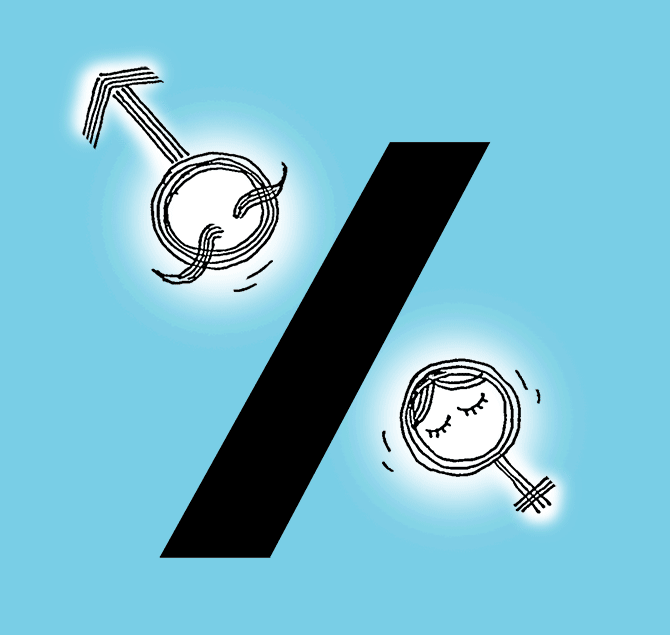 | « Back to article | Print this article |
Violence is just too stark, too TRP friendly and so it gets a lot of attention in the media. But the crime of discrimination is much worse because it is much greater, it attracts no attention and it has no recourse, says Mahesh Vyas.
Illustrations: Dominic Xavier/Rediff.com

Crime against women is usually understood to comprise rape, female infanticide, dowry-related harassment, honour killings and other similar overt forms of violence.
But a greater crime against women is the systematic discrimination against them in jobs. It is a greater crime because of its insidious nature. It is a greater crime as is evident in the numbers.
Women do not participate in the labour force like men do in India. Labour participation rate for women was 14.4 per cent during September-December 2016. This is just one-fifth of the 74.2 per cent rate for men.
Why do women not join the workforce?
The disparity in education isn't as much. About 8.5 per cent men are graduates and 5 per cent women are graduates; 5.6 per cent women cleared their twelfth exams but did not complete graduation, compared to 8.3 per cent men.
The difference in education levels is about 1.6 times, while the difference in labour participation is over 5 times.
The low labour participation runs across rural and urban regions.
Labour participation in rural India was 14.6 per cent and urban participation was lesser at 14.2 per cent. Urban women are better educated than their rural counterparts, but that makes no difference to their labour participation.
Reasons like women need to do household work and take care of children, etc, are not exactly fair.
Besides, I think these reasons are flawed.
Women suffer a higher unemployment rate

During September-December 2016, women faced an unemployment rate of 18.9 per cent compared to the 4.7 per cent unemployment rate for men.
So, compared to men, first, fewer women join the labour force looking for jobs and then, of the few that do, fewer get jobs (compared to men).
I believe that it is this high unemployment rate faced by women that deters them from joining the labour force.
The low labour participation rate for women is the outcome of a high unemployment rate. If women face a substantially higher unemployment rate compared to men, they would rather accept the traditional position of a home-maker than face the humiliation of repeated rejects in the job markets.
But why should women face a much higher unemployment rate compared to what their relative education levels would warrant?
Perhaps, the most credible answer is discrimination.
Entrepreneurs prefer hiring men compared to women.
It is hard to believe that women are systematically substantially worse at work compared to men. The only answer is discrimination.
Women are seen as a greater liability. Their vulnerabilities are perceived to impose a higher cost towards ensuring their security.
Instead of making space to enable all genders to work harmoniously (as they should), entrepreneurs choose the easier path of not hiring women if they can hire men instead.

The Indian Parliament has just made it much more difficult for women to join the labour force.
Entrepreneurs, who have already displayed their discrimination against women are now even more unlikely to hire women because it just became much more costly to do so after lawmakers decided to increase maternity leaves and to make it mandatory for companies to maintain a creche, etc.
If good intentions lead to bad outcomes, this perhaps will be the best example.
What women need are more jobs and less discrimination. The new law will yield the exact opposite.
Women are discriminated against and are also the most vulnerable. They are the first to suffer the results of an economic shock.
During September-December 2016 (the period of the initial shock of demonetisation), women lost 2.2 million jobs while men gained 5.6 million jobs.
The new law is just another shock -- a more enduring one and therefore a much more harmful one.
I repeat the statistics for comparisons: only 14 per cent of women join the labour force and they suffer 19 per cent unemployment while 74 per cent men join the labour force and suffer less than 5 per cent unemployment.
As against this, women who are victims of some kind of violence against them constitute 0.04 per cent of their numbers.
Violence is just too stark, too TRP friendly and so it gets a lot of attention in the media. But the crime of discrimination is much worse because it is much greater, it attracts no attention and it has no recourse.
It is also ill understood as is evident in the counterproductive laws we pass that could very well increase this crime.